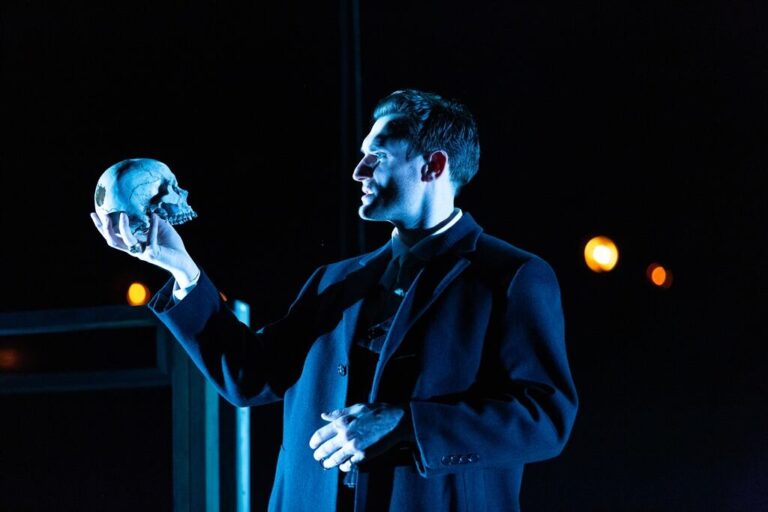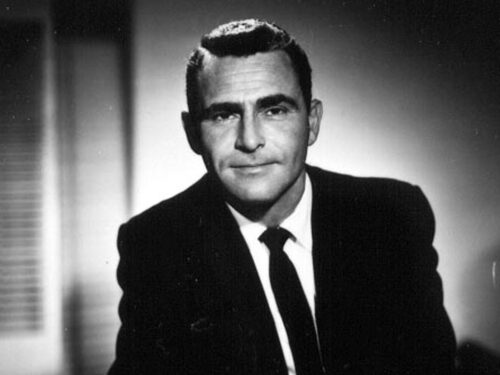WARWICK, R.I. – “Hamlet” is a play of excesses.
It is Shakespeare’s longest work, clocking in at five acts and 30,557 words in its unabridged form. Those words focus largely on the inner thoughts of the play’s endlessly philosophizing and fatally indecisive protagonist, who has been commanded by his father’s ghost to avenge his father’s murder.
The best of those words, as prose and poetry, can be found in Hamlet’s frequent soliloquies, with one – “O what a rogue and peasant slave am I,” where Hamlet expresses his frustration for not being bold enough to take his murderous uncle’s life – running 55 lines. Eventually, the play indulges in the killing off of more of its central characters than any other of the Bard’s plays, including the murderous uncle.
High profile interpretations of the Prince of Demark have also catered to extremes, ranging from David Tennant’s sardonic volatility to Mark Rylance’s pajama-clad insanity to Ethan Hawke’s hipster irony. And the play has quite often lent itself to high concept productions, including Aviva Studios’ 2024 cyberpunk performance using Radiohead’s music as its driving soundtrack, and the Royal Shakespeare Company’s recent staging that turned the court of Elsinore into the seaborne Royal Yacht Scandinavia, complete with a roiling wake and video-projected waves.
At the Gamm Theatre – which credits “Hamlet” for putting it on the theatrical map in 1997, when the then Providence-based playhouse was known as the Alias Stage – the play gets a streamlined production that shuns high concept for grand dramatic gestures.
Michael McGarty’s bare-boned scenic design consists of a multi-tier labyrinth of weathered wood platforms and stairs in front of a translucent black scrim. Nothing hints at a particular time in history for this play to take place, reinforced by Mikayla Reid’s ambiguous costume design that vaguely suggests somewhere between the post-Civil war through pre-World War I America, Mostly, the costuming serves to define each character’s station and status, and separate the younger from the older generation. All this creates a desired timeless quality for this play, which allows us to focus on the words and the intriguingly drawn and marvelously performed characters delivering them.
Jeff Adelberg’s lighting design does the heavy lifting in this production, for intense, oversaturated spotlighting constantly isolates each performer from the surrounding darkness that fills the stage and adds drama and foreboding shadows to everything. It also accentuates small but formidable acting moments – such as the tear falling from Rosencrantz’s eye (an engaging Abigail Milnor-Sweetser) when she first betrays her old friend Hamlet, and the flash of emotional pain that briefly crosses Ophelia’s face (a brilliant Nora Eschenheimer) when Hamlet rejects her love – that might otherwise go undetected beyond the second row. Each scene abruptly ends with a complete blackout accompanied by a deafening percussive beat, which quickly segues to the next scene.
Quick is the catchword for this staging, for speed is of the essence for director Tony Estrella as he works hard to not only keep his production at three hours but in line with the speedreading given by Jeff Church in the title role.
Church’s Hamlet is marred by moments of melancholy and blinded by bitterness, but mostly he is a man of great passion that manifests in his quick, well-articulated speech and hurried physicality. So passionate is this Hamlet that he has no time for stairs – choosing instead to climb onto platforms and leap onto tables – and literally bowls over his mother Gertrude (Jeanine Kane), his best friend Horatio (David Ensor), and his childhood friends Ophelia (Eschenheimer) and Laertes (Marc Pierre) when accosting them with fervent speeches. He does the same when greeting Polonius (Joe Penczak) with a knife to the chest and comes close when accosting his Uncle Claudius (Kelby Akin).
But given his immense talent and training, Church pauses at all the right places to add weight to the words and make the heightened language of Shakespeare’s text sound as if it was newly discovered. He also excels at fencing.
Like the bread in an Italian restaurant and the desserts in a French café, the true litmus test for a production of “Hamlet” is the sword fight. The fatal foil exchange between Church’s Hamlet and Pierre’s Laertes, as choreographed by Normand Beauregard, is the best I’ve ever seen on any stage. Not a thrust is telegraphed or anticipated, not a parry or riposte is insincere, and the outcome – for those unfamiliar with the play’s complete title, “The Tragedy of Hamlet, Prince of Denmark” – is always in question until it’s not.
For a play known for its excesses, this Gamm Theatre production astounds with its subtlety.
HAMLET
Play by William Shakespeare. Directed by Tony Estrella. At the Gamm Theatre, 1245 Jefferson Boulevard, Warwick. Runs through April 27. Tickets $65-$75, plus fees. 401-723-4266, gammtheatre.org.
Bob Abelman is an award-winning theater critic who formerly wrote for the Austin Chronicle. Connect with him on Facebook.




Comment count: